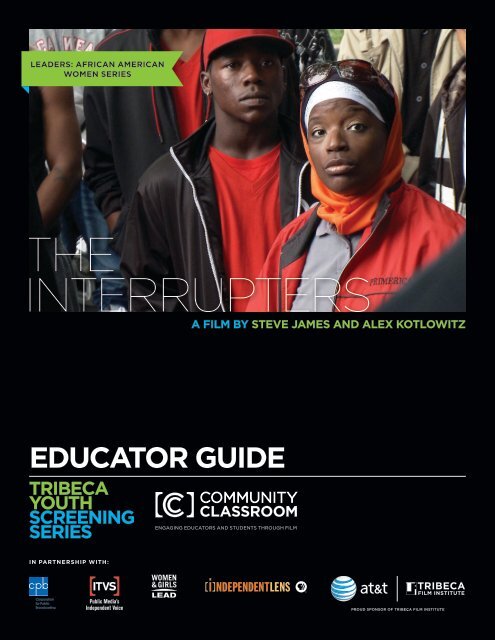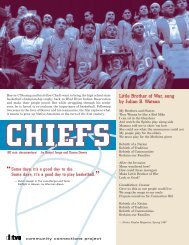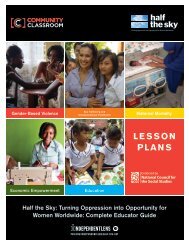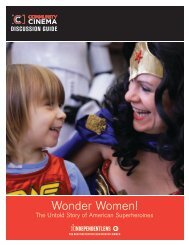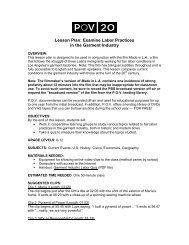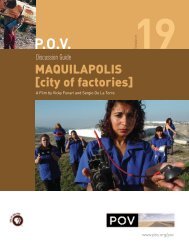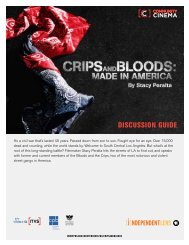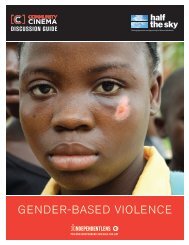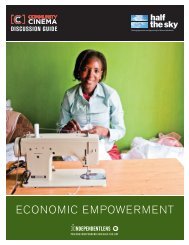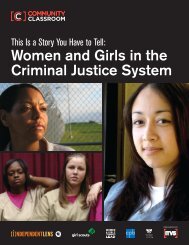interrupters-educator-guide - ITVS
interrupters-educator-guide - ITVS
interrupters-educator-guide - ITVS
- No tags were found...
Create successful ePaper yourself
Turn your PDF publications into a flip-book with our unique Google optimized e-Paper software.
VIEWING/DISCUSSING THE MODULES cont.INTRODUCE MODULE 2You will need: Pens and writing paper, LCD projector or DVD player, Film Module: The Interrupters, Ameena& Caprysha [9:42], Student Handout A: Film Module Worksheet• Ask students to continue taking notes on their graphic organizer while viewing another modulethat explores Ameena’s mentorship with a troubled teen named Caprysha. Tell students to keep theworksheet for reference during the post-screening discussion. Instruct students to fill in their graphicorganizer while viewing a module introducing Ameena’s background and highlighting her work in thestreets. Tell students to keep the worksheet for reference during the post-screening discussion.MODULE 2 post screening discussionYou will need: Pens and writing paper, Student Handout A: Film Module Worksheet1. Begin by discussing the film module and ask for volunteers to share their notes on Student HandoutA: Film Module Worksheet. Use the following prompts to <strong>guide</strong> the class discussion:• Why do you think young women like Caprysha get involved in violent activity? What unique realitiesaffect young women such as Caprysha?• In the film module, Ameena calls Caprysha “Little Meena.” What do Ameena and Caprysha have incommon? Why does Ameena make a particularly good mentor for a young woman in Caprysha’ssituation?• Describe Ameena’s approach to mentoring Caprysha. What challenges does she face in trying to getCaprysha to follow the right path?• Who/what were some of Ameena’s violence <strong>interrupters</strong>?8
POST-SCREENING ACTIVITY cont.6. Ameena is one of only a couple of women who work at CeaseFire. Although women are often characterized as victims of gangand street violence, they also play an active role in both violence and violence prevention. Will CeaseFire’s conflict resolutionefforts be successful without the involvement of female violence <strong>interrupters</strong>? Using their knowledge of Ameena, havestudents write a proposal to CeaseFire, outlining the ways that women can become part of the conflict resolution process.7. Read rapper Nas’ Open Letter to Young Warriors in Chicago, written in response to Derrion Albert’s death (ac360.blogs.cnn.com/2009/09/30/open-letter-to-young-warriors-in-chicago). Ask students to write their own open letter to the youth ofChicago.8. Explain to students that a “social-ecological model” of violence prevention been suggested as a way of considering themultiple factors that contribute to violence: individual, relationship, community, society, and environment. Have students goto The Center for Action Civics (centerforactioncivics.org/site/files/963/122146/411514/565737/Ecological_Model.pdf) toexplore the four factors. Ask students to chose one individual from the film and create a social-ecological map of the differentfactors that contribute to that person’s experience with violence.9. Have students research community-based violence prevention programs in their neighborhood and conduct a programevaluation to determine the effectiveness of those programs. If possible, have students visit the website, read annual reports,and interview clients and administrators. Ask students to note the organization’s understanding of the root causes of violence,what kinds of services they provide, and who funds them. Have students prepare a presentation about one effective programthat exists in their community.10. Help students place violence prevention in a global perspective by having them watch “Women, War, and Peace”(pbs.org/wnet/women-war-and-peace) and use the engagement resources to reflect on the themes of the film. (itvs.org/films/womenwar-and-peace/engagement-resources).Assign an essay, asking students to make a comparison between Ameena’s work inChicago and the work of women peacemakers abroad.ResourcesBooksKotlowitz, Alex, There Are No Children Here TheStory of Two Boys Growing Up in the Other America.New York: Anchor Books, Doubleday, 1991.McCollum Sharon L., Banas, Sean, Murphy, MadonnaM., Managing Conflict Resolution. New York: InfobasePublishing, 2009.FilmsWill I Be Next? Directed by Ralph Rollins,produced by Jeff McCarter and Elizabeth Czekner.mediathatmattersfest.org/watch/9/will_i_be_nextCrips and Bloods: Made In America. Directed byStacy Peralta, produced by Baron Davis.cripsandbloodsmovie.com/about.htmlBastards of the Party. Directed by Cle Sloan,produced by Alex Demyanenko.bastardsofthepartydvd.com12
ALIGNMENT TO STANDARDSWriting Standards 9-10, 11-12#1 Write arguments to support claims in an analysis of substantive topics or texts, using valid reasoning and sufficient evidence.#2 Write informative/explanatory texts to examine and convey complex ideas, concepts, and information clearly and accurately throughthe effective selection, organization, and analysis of content.#3 Write narratives to develop real or imagined experiences or events using effective technique, well-chosen details, and well-structuredevent sequences.#4 Produce clear and coherent writing in which the development and style are appropriate to task, purpose, and audience.#5 Use technology, including the Internet, to produce, publish, and update individual or shared writing products, taking advantage oftechnology’s capacity to link to other information and to display information flexibly and dynamically.#6 Conduct short as well as more sustained research projects to answer a question (including a self-generated question) or solve aproblem; narrow or broaden the inquiry when appropriate; synthesize multiple sources on the subject, demonstrating understanding ofthe subject under investigation.#7 Gather relevant information from multiple authoritative print and digital sources, using advanced searches effectively; assess theusefulness of each source in answering the research question; integrate information into the text selectively to maintain the flow ofideas, avoiding plagiarism and following a standard format for citation.SPEAKING AND LISTENING 9-10, 11-12#1 Initiate and participate effectively in a range of collaborative discussions (one-on-one, in groups, and teacher-led) with diverse partnerson grades 9–10 topics, texts, and issues, building on others’ ideas and expressing their own clearly and persuasively.#3 Evaluate a speaker’s point of view, reasoning, and use of evidence and rhetoric, identifying any fallacious reasoning or exaggerated ordistorted evidence.#4 Present information, findings, and supporting evidence clearly, concisely, and logically such that listeners can follow the line ofreasoning and the organization, development, substance, and style are appropriate to purpose, audience, and task.#5 Make strategic use of digital media (e.g., textual, graphical, audio, visual, and interactive elements) in presentations to enhanceunderstanding of findings, reasoning, and evidence and to add interest.#6 Adapt speech to a variety of contexts and tasks, demonstrating command of formal English when indicated or appropriate.WRITING STANDARDS FOR LITERACY IN HISTORY/SOCIAL STUDIES, SCIENCE AND TECHNICAL SUBJECTS 9-10, 11-12#1 Cite specific textual evidence to support analysis of primary and secondary sources, attending to such features as the date and originof the information.#2 Determine the central ideas or information of a primary or secondary source; provide an accurate summary of how key events or ideasdevelop over the course of the text.#3 Analyze in detail a series of events in a text; determine whether earlier events caused later ones or simply preceded them.National Curriculum Standards for Social Studies#1 CULTURE: Through the study of culture and cultural diversity, learners understand how human beings create, learn, share, and adaptto culture, and appreciate the role of culture in shaping their lives and society, as well the lives and societies of others. In schools, thistheme typically appears in units and courses dealing with geography, history, sociology, and anthropology, as well as multiculturaltopics across the curriculum.#2 PEOPLE, PLACES, AND ENVIRONMENTS: This theme helps learners to develop their spatial views and perspectives of the world, tounderstand where people, places, and resources are located and why they are there, and to explore the relationship between humanbeings and the environment. In schools, this theme typically appears in courses dealing with geography and area studies, but it is alsoimportant for the study of the geographical dimension of other social studies subjects.#3 INDIVIDUAL DEVELOPMENT AND IDENTITY: Personal identity is shaped by family, peers, culture, and institutional influences. Throughthis theme, students examine the factors that influence an individuals personal identity, development, and actions.#4 INDIVIDUALS , GROUPS, AND INSTITUTIONS: Institutions such as families and civic, educational, governmental, and religiousorganizations, exert a major influence on people’s lives. This theme allows students to understand how institutions are formed,maintained, and changed, and to examine their influence.#5 POWER, AUTHORITY, AND GOVERNANCE: One essential component of education for citizenship is an understanding of the historicaldevelopment and contemporary forms of power, authority, and governance. Through this theme, learners become familiar with thepurposes and functions of government, the scope and limits of authority, and the differences between democratic and non-democraticpolitical systems.#6 CIVIC IDEALS AND PRACTICES: An understanding of civic ideals and practices is critical to full participation in society and is anessential component of education for citizenship. This theme enables students to learn about the rights and responsibilities of citizensof a democracy, and to appreciate the importance of active citizenship.13
STUDENT HANDOUT A: FILM MODULEWORKSHEETDirections: As you watch the modules, fill in the graphic organizer with evidence from the film of her keycharacteristics, connections, and quotes.PERSONAL EXPERIENCESPERSONALITY TRAITSCONNECTIONS TOTHE COMMUNITYQUOTES14
STUDENT HANDOUT B:ACTIVIST SPOTLIGHTDirections: The Nobel Women’s Initiative’s website features profiles of women from around the world whosework promotes peace-work that is often carried out in the shadows with little recognition. Your assignment isto design and write an “Activist Spotlight” page for Ameena Matthews to be included on the Nobel Women’sInitiative’s website.Step 1: View examples of other Activist Spotlights on the Nobel Women’s Initiative’s website:nobelwomensinitiative.org/spotlight. In the space below, write down a list of the components of an ActivistSpotlight:Step 2: Gather research for your profile:• Interview: “Meet Ameena Matthews, One of Chicago’s Gang ‘Interrupters’”: indiewire.com/article/interview_meet_ameena_matthews_one_of_chicagos_gang_<strong>interrupters</strong>• Interview: “It’s a warzone here - a look the Interrupters and interview with Ameena Matthews”:permanentplastichelmet.com/2011/12/06/its-a-warzone-here-a-look-at-the-<strong>interrupters</strong>-and-interview-withameena-matthews• Interview: “How Can We Interrupt Violence?”: msmagazine.com/blog/blog/2011/09/13/how-can-weinterrupt-violence• Interview: “It’s Either Kill or Be Killed...”: pbs.org/wgbh/pages/frontline/social-issues/<strong>interrupters</strong>/its-eitherkill-or-be-killed• Video: Ameena Speaks at a Young Man’s Funeral: youtube.com/watch?v=uVzHX8qsrqE• Video: Ameena’s Prayer Vigil: youtube.com/watch?v=uVzHX8qsrqEStep 3: Write and publish your activist profiles online using one of the following blogging platforms:• Edublogs: edublogs.org• Pen.io: pen.io• Pencamp: pencamp.com15
TEACHER HANDOUT:ACTIVIST SPOTLIGHT RUBRICExceeding theStandardMeeting theStandardApproaching theStandardEmergingContentI select many specificdetails that show what isimportant and interestingabout the person.I use someappropriate detailsto show what isimportant andinteresting aboutthe person.I use a few details,but the readerdoesn’t really learnwhat is importantand interesting aboutthe person.I do not use verymany details, andthe reader doesnot learn whatis important orinteresting aboutthe person.Language:VocabularyI use interesting and livelywords that show ratherthan tell about the person.I use interestingwords to describethe person.I use someinteresting words,but most of thelanguage in myarticle is ordinary.The languagein my article isordinary.Language:QuotationsWhen it makes sense todo so, I include some ofthe person’s exact wordsin quotation marks inmy article along with mydescriptions of what theperson said to make thestory more interesting.Sometimes I includethe person’s exactwords.I try to include theperson’s exact words,but sometimes itdoesn’t really makesense.I do not includeany of theperson’s exactwords.ConventionsI do not have anymistakes in sentences,spelling, punctuation, orcapitalization in my article.I do not haveany mistakes insentences, spelling,punctuation, orcapitalizationthat make it hardfor the reader tounderstand what Ihave written.I have a fewmistakes insentences, spelling,punctuation, andcapitalization thatmake it hard for thereader to understandwhat I have written.I have so manymistakes insentences,spelling,punctuation, andcapitalizationthat readershave a hard timeunderstandingwhat I havewritten.MultimediaI effectively integratemultimedia featuresthroughout the spotlight.The photo and video arehigh-quality, support thespotlight’s purpose, andare appropriate for theaudience.I use multimediafeatures effectivelythroughout thespotlight. The photoand video arehigh-quality andrelate to the topic.I try to usemultimedia thespotlight, but someof the photos orvideo are low-qualityor do not relate wellto the topic.I do not usemultimedia onmy spotlight.*Adapted from Intel’s Assessing Projects Library: educate.intel.com/pk/AssessingProjects16
engaging <strong>educator</strong>s and students through film<strong>ITVS</strong> Engagement and Education StaffAssociate Director of Engagement & EducationDuong-Chi DoEducation ManagerAnnelise WunderlichNational Community Engagement CoordinatorSara Brissenden-SmithEngagement & Education AssistantNallaly JimenezMedia Services ManagerBenita StillsTribeca Youth Screening Series StaffExecutive Director,Tribeca Film InstituteBeth JansonEducation DirectorVee BravoSchools CoordinatorAshley FarmerEducation AssistantRachel MillerDesignerJulia YangCOMMUNITY CLASSROOMCommunity Classroom is an innovative and free resource for <strong>educator</strong>s, offering short-form film modulesadapted from <strong>ITVS</strong>’s award-winning documentaries and standards-based lesson plans for high school andcommunity colleges, NGOs, and youth organizations. itvs.org/<strong>educator</strong>s/collections<strong>ITVS</strong>Independent Television Service (<strong>ITVS</strong>) funds, presents, and promotes award-winning independentlyproduced documentaries and dramas on public television and cable, innovative new media projects on theWeb, and the Emmy ® Award-winning series Independent Lens on PBS. <strong>ITVS</strong> receives core funding from theCorporation for Public Broadcasting, a private corporation funded by the American people. Women andGirls Lead is a strategic public media initiative to support and sustain a growing international movementto empower women and girls, their communities, and future generations. To learn more, visit itvs.org/women-and-girls-leadtribeca film instituteTribeca Film Institute is a year-round nonprofit arts organization that empowers filmmakers through grantsand professional development, and is a resource for and supporter of individual artists in the field. TheInstitute’s educational programming leverages an extensive network of people in the film industry to helpNew York City students learn filmmaking and gain the media skills necessary to be productive citizens andcreative individuals in the 21st century. tribecafilminstitute.orgTribeca Youth Screening SeriesThe Tribeca Youth Screening Series is a free-of-charge program that brings New York City public middleand high school students and teachers to screenings at Tribeca Cinemas and during the Tribeca FilmFestival. Films are chosen for their educational relevance, but also for their cinematic merits. Studentsare exposed to independent films, filmmakers, and subject matter not typically explored in mainstreamHollywood fare, and teachers are supplied with a film text that can serve as a unique supplement to theircurriculum. In order to facilitate further study of films, TFI creates original study <strong>guide</strong>s for each film andworks with teachers to incorporate both these and TFI’s Teaching Artists in the classroom.Allison Milewski: Arts and Media Education Consultant, Curriculum Specialist, and Founder, PhotoForwardLoira Limbal: Independent Filmmaker and Deputy Director of Firelight MediaAdditional program support provided by:This program is supported, in part, by public funds fromthe New York City Department of Cultural Affairs.Honorable Margaret S. Chin,New York City CouncilHonorable Scott M. Stringer,Manhattan Borough PresidentThis program is supported, in part, by public funds from the New York City Department of Cultural Affairs in partnership with the City Council16


